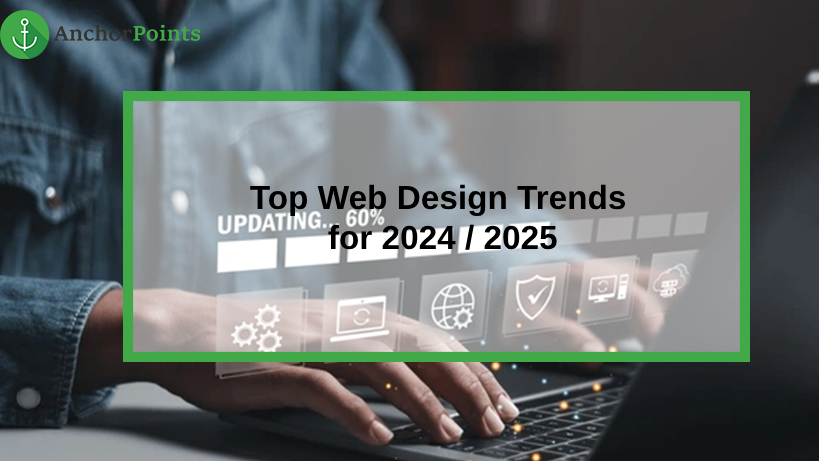
Web design trends represent the cutting edge of innovation in the constantly changing digital landscape. In order to produce websites that are not only aesthetically beautiful but also captivating and easy to use, they are continuously pushing the envelope. Let's take a closer look at some of the most popular trends that will distinguish your website in 2024 and 2025.
1. Dynamic Scrolling Experiences: Breathe Life into Your Website
Imagine scrolling through a website that feels alive. Interactive animations and effects triggered by your scrolling create a captivating journey, encouraging users to explore further. Think about subtle fades, color shifts, or elements moving into place as you scroll, similar to the rotating text on The Cookery School's website. These dynamic experiences add a layer of interactivity and keep users engaged with your content.
2. Amplifying Interactions with Micro-Moments: Beyond the Basic Hover
Micro-interactions are subtle yet impactful animations that enhance user experience. They go beyond the basic hover effect on a link that simply changes color. Imagine vibrant explosions of color triggered by clicks on buttons, or mesmerizing gradients that shift as you scroll down a page. These elevated interactions add a touch of delight and surprise, making your website feel more responsive and engaging.
3. Seamless User Guidance with Micro-Animations: A Helping Hand
As the name suggests, micro-animations are tiny animations used strategically to guide users through their website experience. They can be playful, like the ones on Smashmallow's hero image, adding a touch of personality. However, they can also be purely functional, helping users navigate intuitively – like progress bars subtly indicating loading times. In 2024, the focus will be on integrating these animations seamlessly with organic movements, mimicking real-world physics rather than flat, static effects. This creates a more natural and intuitive user experience.
For e-commerce websites, micro-animations can be particularly powerful. Imagine seeing clothing come alive on models, showcasing their fit and movement in a dynamic way. This allows users to explore products in more detail, leading to a more informed purchasing decision.
4. The Art of Empty Space: Mastering Negative Space for Clarity
Negative space, also known as white space, is crucial for creating clean and uncluttered layouts. This trend emphasizes the importance of achieving a balance between content and empty areas. Think of Apple.com – a masterclass in using negative space to draw attention to key elements and enhance readability. By effectively utilizing margins, padding, and line spacing, negative space allows for a more intuitive and aesthetically pleasing user journey.
5. Interactive 3D: A Gateway to Immersion
With advancements in web technology, designers are increasingly incorporating interactive 3D elements to create truly immersive experiences. Websites like Campo Alle Comete showcase the breathtaking potential of this trend. 3D models can be used for various purposes, such as offering lifelike product representations in e-commerce. This allows users to explore every detail of a product from any angle, fostering trust and potentially boosting conversions.
6. Gamification: Engaging Users Through Playful Challenges
Gamification involves incorporating game-like elements such as points, rewards, and challenges into your website. This strategy aims to increase user engagement, keep them coming back for more, and potentially encourage them to share information. Adding interactive sections like quizzes, polls, calculators, or contests can provide value to visitors. These sections not only encourage users to explore your site but also reveal valuable insights about their preferences. Imagine offering a mortgage calculator on a realtor's website. This tool provides value to potential customers while gathering valuable data that can be used for marketing purposes.
7. Organic Shapes: A Flowing Departure from Geometry
While geometric shapes dominated website design trends in 2020, 2024 welcomes the rise of organic shapes. Think of the natural world – hills, curving lake edges, or the asymmetrical beauty of a winding river. These shapes can be used to break up sections of a website without harsh lines, adding a touch of softness and visual interest. Take inspiration from Android's use of circles behind products on their homepage for a fantastic example.
8. Smart Video: Purposeful Content Beyond Entertainment
Video has long been considered essential for websites, captivating audiences who may prefer watching over reading. However, in 2024, the focus shifts towards "smart" video – video with a clear purpose and meaning. Gone are the days of simply embedding a random YouTube video. Well-crafted, high-quality videos that directly address frequently asked questions are key. This makes your website a valuable resource and establishes your brand as an authority within your industry.
9. Dark Mode: A User-Friendly and Stylish Choice
Dark mode offers a practical and aesthetic advantage. By reducing eye strain, it caters to the increasing screen time of modern users. Moreover, it creates a sleek, modern look, allowing you to highlight key elements by contrasting them against a darker background.
10. Blending Photos and Graphics: A Creative Fusion
The trend of overlaying graphics on images is not just confined to social media. This creative technique adds a layer of visual interest and personality to websites. By blending photography with graphics, you can strengthen your brand identity and keep visitors engaged with your content.
11. Full-Height Homepage Hero: A Bold Statement
A full-height hero section acts like a digital billboard, capturing immediate attention and delivering a powerful message. It provides an ideal canvas for storytelling, allowing you to showcase your brand's personality and values. While considering different screen sizes and browser dimensions is crucial, the emphasis on scrolling has reduced the importance of keeping all critical content "above the fold."
12. Chatbots: Evolving into "Chatbuds"
Chatbots have become increasingly popular, and this trend is set to continue. As AI and machine learning advance, we can expect chatbots to become more sophisticated, handling complex customer service queries and even personalizing shopping experiences.
For instance, a chatbot could proactively suggest a free phone upgrade to a customer seeking support, enhancing their experience and reducing the need for human intervention. To manage the workload, consider utilizing tools that forward web chat conversations to your mobile device, allowing you to engage with customers on the go.
In conclusion, by staying up-to-date with the latest web design trends, you can create websites that not only look stunning but also deliver exceptional user experiences. AnchorPoints can help you leverage these trends to elevate your digital presence.
Contact us today to discuss your project and embark on a journey towards a more engaging and effective online platform.

